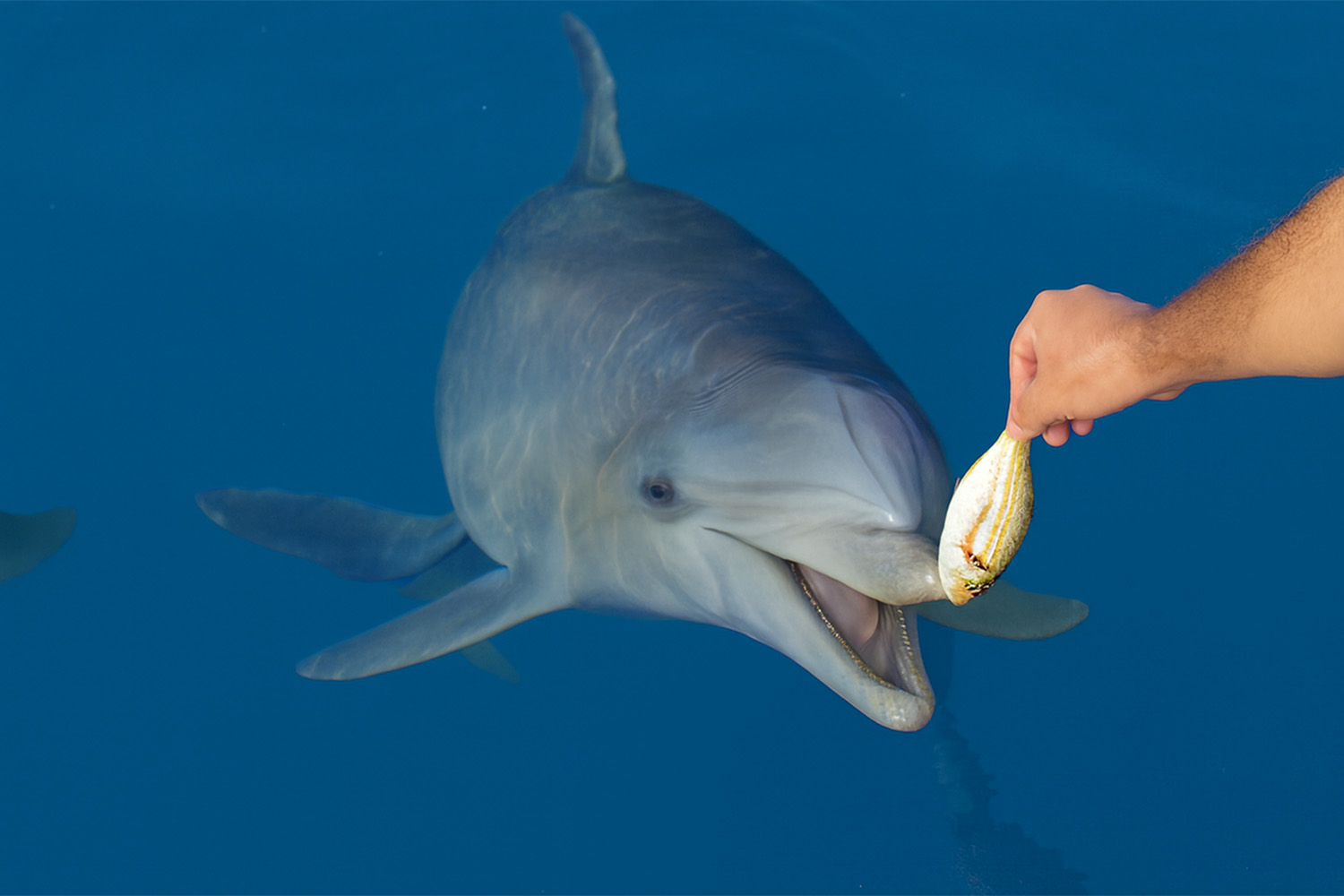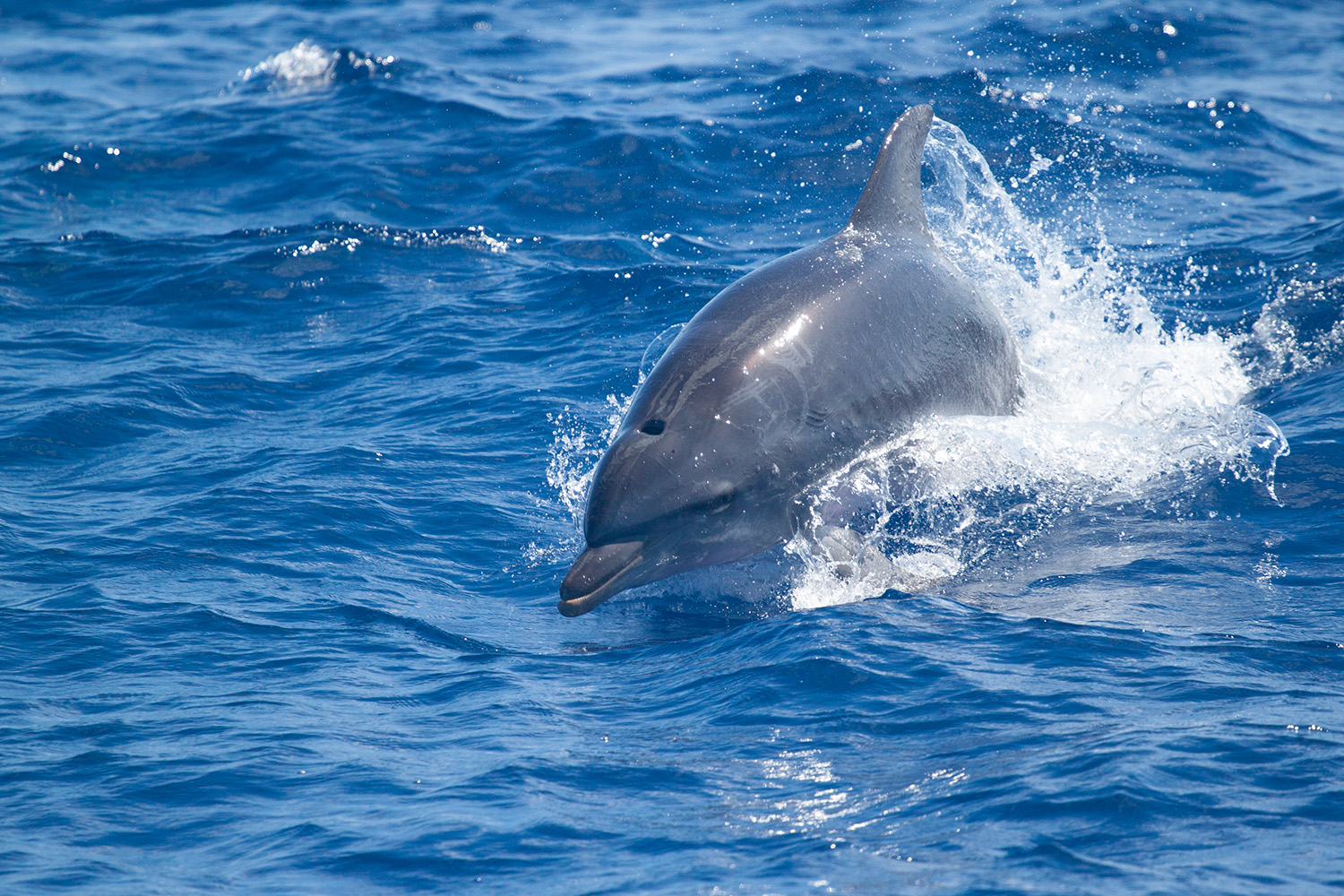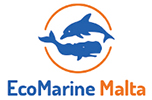
Why Feeding Wild Dolphins Is Dangerous
During summer, we see it all.
Jet skis chasing dolphins at full speed. Boats blasting music.
Tourists and locals jump in to swim with wild pods.
Groups are being separated. Mothers and calves are getting cornered. And now people feed dolphins from their boats like it’s part of the show.
These acts aren’t innocent. They’re not “fun” or “harmless
These acts are harassment — and they show a deep disrespect for some of the most intelligent, social, and protected animals in the Mediterranean Sea.
It starts with a bucket of fish.
You’re on a boat, the sun is shining, and a pod of dolphins swims near. One pops up, curious and close. You reach into your cooler and toss it a fish. It feels magical — like a connection with nature.
But that fish may be the first step in destroying that dolphin’s ability to survive.
Feeding wild dolphins might seem harmless, even kind. However, science — and years of observation — demonstrate that it causes real harm to these animals.
Here’s why:
Feeding Wild Dolphins Changes Their Natural Behaviour
Dolphins are smart, social predators. In the wild, they spend 80–90% of their day hunting and foraging. But when humans feed them, that changes.
Instead of hunting, they start begging.
Over time, dolphins fed by people stop teaching their young how to hunt. They hover near boats or the shore, waiting for handouts. This shift in behavior makes them less independent and more vulnerable.
📘 A study by NOAA found that dolphins conditioned to human feeding spend significantly less time foraging and more time near humans, increasing their risk of harm (NOAA, 2019).
It Puts Dolphins in Real Danger
Dolphins who associate boats with food start taking more risks:
- They approach engines and propellers.
- They hang around fishing gear and get hooked or entangled.
- They may even become aggressive toward people or other dolphins if they expect food and don’t get it.
This isn’t theoretical — it happens across coasts, including the Mediterranean. And while people might think they’re creating a special moment, they’re actually rewiring the dolphin’s natural instincts into something unnatural and harmful.
📘 In Sarasota Bay, Florida, researchers documented over 30 dolphins injured or killed due to human interactions tied to feeding (Wells, R.S., et al., 2015. Behavioural consequences of human interactions with free-ranging bottlenose dolphins in Sarasota Bay. Marine Mammal Science)
Human Food Isn’t Dolphin Food
Even if you feed them fish, it’s not the same.
Wild dolphins eat a diverse diet. A scientific study of stranded bottlenose dolphins (Neri, A., et al., 2023) off the coast of Tuscany revealed that:
- Their natural diet was extraordinarily varied—69 prey species, including European hake, conger eels, octopod cephalopods, and snake blennies.
- This diversity reflects the need for a balanced, natural diet with nutrients from across the ecosystem
Hand‑feeding—even with fish—can’t match this variety. It fails to meet the complex nutritional needs of dolphins, which could ultimately undermine their health and well-being over time.
A steady diet of bait fish or freezer fish lacks the variety and nutrients they need. Worse, some people feed them hot dogs, chips, or leftovers, thinking it’s cute or funny.
This can cause malnutrition, illness, and even death
It’s Illegal — and For Good Reason
Feeding wild dolphins is a federal offense in the U.S. under the Marine Mammal Protection Act (1972). Penalties can include fines up to $100,000 and even jail time.
Why so serious? Because feeding dolphins doesn’t just break a rule — it breaks their natural life cycle. (https://www.fisheries.noaa.gov/topic/laws-policies/marine-mammal-protection-act)
In Europe and therefore in Malta and Mediterranean Sea Bottlenose dolphins are protected under:
- EU Habitats Directive (92/43/EEC)
Main tool: This is the European Union’s closest equivalent to the MMPA.
- Annex IV lists bottlenose dolphins and other cetaceans as strictly protected species.
- It prohibits:
- Deliberate capture or killing
- Disturbance (especially during breeding, rearing, migration)
- Destruction of breeding/resting sites
🔒 Feeding dolphins from boats qualifies as “disturbance”, which is illegal under this directive
- The Barcelona Convention (and its SPA/BD Protocol)
Applies to Mediterranean countries, including EU and non-EU members.
- Recognizes cetaceans as endangered or threatened species
- Requires parties to prevent, reduce, or eliminate human activities that disturb them
- Feeding is considered a form of interference or harassment
In countries like Malta, this means dolphins are legally protected even if there’s no local law explicitly mentioning feeding.
- ACCOBAMS Agreement
(Agreement on the Conservation of Cetaceans of the Black Sea, Mediterranean Sea and Contiguous Atlantic Area)
- A regional agreement under the Bonn Convention (CMS)
- Binding for over 20 countries, including France, Italy, Spain, Greece, Malta, and Monaco
- Promotes coordinated efforts to:
- Minimise disturbance
- Improve habitat protection
- Prevent harmful interactions — including feeding and boat-based harassment
- Bern Convention (1979)
Applies across Europe.
- Protects wild flora and fauna, including all cetaceans
- Prohibits disturbance, killing, or capture
- Obligates governments to penalize violations through national laws
In Malta, although there’s no specific national law that explicitly states “do not feed dolphins,” they’re protected by default. Under these conventions and local regulations, feeding wild dolphins is treated as illegal interference with a protected species.
A Real Story: A Dolphin Called Beggar
Though this story happened in the U.S., it mirrors the warning signs we now see in the Mediterranean.
“Beggar” was a bottlenose dolphin who became famous for begging for food from tourists off the Florida coast. Over the years, thousands fed him.
- He stopped hunting.
- He followed boats.
- He got injured — repeatedly.
And in 2012, he died.
A necropsy showed plastic, fishing gear, and partially digested human-provided fish in his stomach. He was underweight, sick, and dependent.
This wasn’t a dolphin killed by nature. It was a dolphin killed by human kindness gone wrong.
Malta has its own “Beggar” stories starting to unfold — but we still have time to change the outcome.
What You Can Do Instead
Want to help dolphins? Here’s how to do it responsibly:
- Don’t feed them. Ever.
- Don’t encourage others to do it.
- If you’re on a boat tour, make sure it follows responsible wildlife guidelines.
- Report illegal feeding to local marine authorities or NGOs. (Malta Sea Ranger Unit , Environment Resource Authority )
Watching dolphins in the wild is unforgettable. But the best encounters are the ones where dolphins stay wild and free — not performing tricks for snacks.
Feeding dolphins in the wild isn’t generous. It’s harmful, illegal, and potentially deadly for the very animals we’re trying to connect with.
Let dolphins stay wild. Respect their space. Don’t feed them — not in Malta, not anywhere. Because the next time someone throws a fish from a boat, it might be the beginning of the end for a dolphin who trusted too much.

Bottlenose dolphin in Malta showing signs of malnutrition — its ribs are clearly visible.
Photo credit: Patrizia Patti / @ecomarinemalta
Cover picture AI-manipulated image for illustrative purposes.

